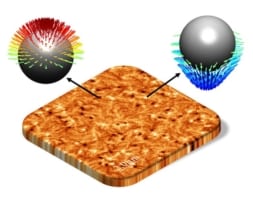
An unusual type of sound wave that can travel backwards in space and has previously only been observed in ultracold quantum systems may also exist at ambient temperatures in artificially-engineered materials. Researchers led by Martin Wegener at Germany’s Karlsruhe Institute of Technology (KIT) found evidence for these unusual sound waves, known as rotons, in a so-called “metamaterial” that was designed to shape the flow of acoustic waves. The result might make it easier to manipulate sound in air as well as in solid materials.
In normal sound waves, or phonons, the energy of the sound wave travelling through a medium increases linearly with its momentum. With rotons, however, low energy can be associated with high momentum. Certain frequencies of rotons also generate three different co-existing acoustical modes with the same polarization but different wavelengths. The slowest of these three modes is a backward wave, or “return flow” as the 20th-century physicist Richard Feynman put it.
Until now, rotons – which, like phonons, are particle-like collective excitations or quasiparticles – have only been studied in ultracold quantum systems such as helium-3 and, more recently, Bose-Einstein condensates (BECs). These systems contain electrons that interact strongly with each other in a way that allows them to behave like superfluids – that is, a fluid that flows without any friction. This superfluidic behaviour was first predicted by the Soviet physicist Lev Landau, who suggested that it was due to the presence of phonons and rotons. However, superfluid helium-3 and BECs only exist at temperatures just above absolute zero, which somewhat limits their technical applications.
Roton-like behaviour
Wegener and colleagues designed their model metamaterials such that each unit, or cell, within the material interacts with its third-nearest neighbours. The researchers then used these structures to “mould” the flow of acoustic waves through the material. In their simulations, they observed roton-like behaviour without any quantum effects under normal ambient conditions and at almost any wavelength.

Rotons spotted in Bose–Einstein condensate
The KIT researchers have now begun making real metamaterials based on their design. To replicate the structures in their simulations, they are using an ultraprecise laser printing technique that can “write” a host of different microstructures with a tightly-focused “pen” of light in three dimensions. “Currently we are working on finding direct experimental proof for the existence of rotons,” Wegener tells Physics World. “We hope to submit our results for publication soon.”
The researchers report their present work in Nature Communications.



